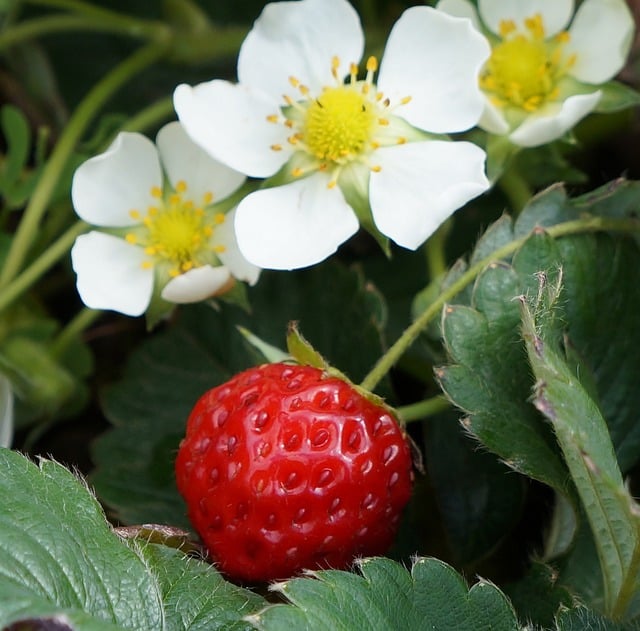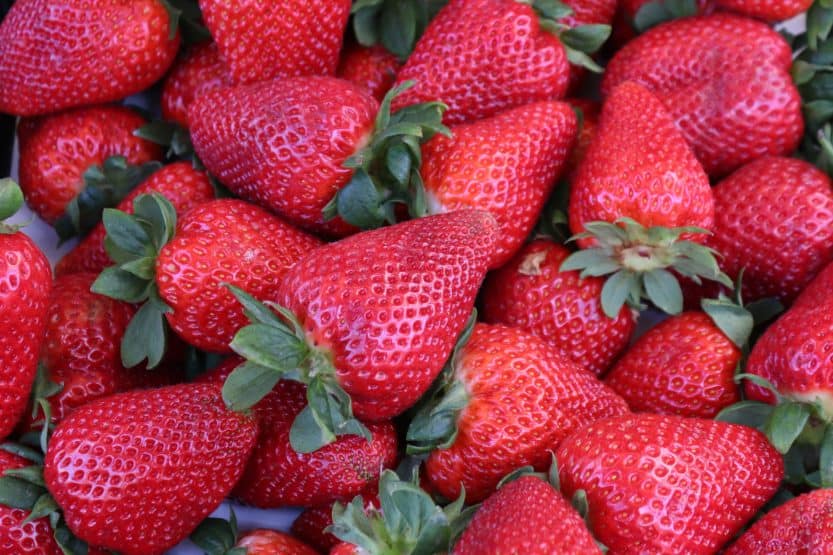Fresh, sweet, home-grown strawberries from the garden are one of the summer season’s best, little treats. Along with their sweet flavor, strawberries are an excellent source of vitamin C while also being a good source of folate, vitamin A and potassium.
Strawberries are one of the easier plants to grow in the garden, or in a container if space is limited. The first thing to take into consideration when planting strawberries is what type of plant that you want to grow.
Buy Strawberry Plants Online
| Image | Name | Rating | Shop |
|---|---|---|---|
 | Burpee ‘Seascape’ Ever-Bearing Strawberry 25 BARE ROOT PLANTS | ||
 | 30 Albion Everbearing Strawberry Plants | ||
 | Quinalt Everbearing Strawberry 25 Bare Root Plants |
Types of Strawberries to Grow
Strawberries come in four main varieties: Ever-Bearing, June bearing, Day Neutral and Alpine.
Everbearing Strawberries
Ever-Bearing strawberries (Buy Online) provide a perpetual harvest, throughout the year, and tend to do well in home gardens.
June Bearing Strawberries
June bearing varieties produce all their berries in June, or the early summer, and are commonly grown in commercial plantings.
Day Neutral Strawberries
Day Neutral strawberries are similar to the ever-bearing variety, but produce fewer strawberries and more sporadically throughout the season.
Alpine Strawberries
Alpine strawberries are a wild-type of strawberry, with very small fruit and considerably lower yields; but the plant makes up for these shortcomings, with very flavorful berries.
Best Time to Plant Strawberries
Strawberry plants can be planted very early in the season, as long as the temperature is above 20 degrees Fahrenheit (-6 C). Even though it’s possible to start strawberry plants from seed, it’s not very common. Most strawberry plants are started from established plants, which are either runner clones or tissue-culture clones.
Most garden centers carry potted strawberry plants, but you can order bare-root strawberry plants online or from catalogs. When purchasing strawberry plants from a nursery or garden center, be sure select plants that look healthy, with no brown spots or any other signs of disease.
Planting Strawberries

Strawberry Plant Soil Requirements

Strawberry plants prefer a rich, fertile soil (Buy Online) with a pH of 5.8 to 6.2. If your soil is sandy or has very poor fertility, then add 0generous amounts of compost to the whole planting area. Strawberry plants grown in poor soils will be prone to disease.
Poor soil will also reduce the plants’ yield, and the berries that do form will be small and lacking in flavor. Once the area has been prepared, you can plant the bare-root or potted plants.
Strawberry Plant Spacing
If you are starting with bare-root strawberry plants, then soak the roots in warm water before planting them at a depth of 2 inches (5 cm), while spacing them 12 inches (30.5 cm) apart. With potted plants, dig a hole large enough to accommodate the root ball; and then place the plant in the hole, making sure not to cover the crown with soil. Water the strawberry plants thoroughly afterward and continue watering daily until the plants begin to perk up.
Keep your strawberry plants well watered throughout the season since they will need about 1 inch (2.5 cm) of water a week. Be careful not to over water them though because strawberry plants are very prone to fungal diseases.
Strawberry Plant Weed Control
Strawberry plants remain short throughout their lives, so weeds can become a serious problem. Make sure to remove any weeds that crop up early in the season. Remove any weeds by hand around strawberry plants; and when doing so, be careful not to disturb the plants’ shallow root systems.
The best long-term solution to control weeds and retain moisture is to add a thick layer of mulch to the area, once the plants are at least 4 to 5 inches (10 to 12.5 cm) tall. Adding mulch is also highly recommended when growing strawberries, in order to keep the fruit from rotting as they ripen, by keeping them off the dirt.
Strawberry Plant Care & Harvest

Strawberry plants are very easy to care for; and if left to their own devices, they will gladly spread through the garden via their runners.
How to Control Strawberry Runners
Most runners should be removed, in order to focus the plants’ energy on fruit production rather than generating new plants. Once the plants are towards the end of their 3 to 5-year lifespan, you can allow them to send out runners to replace themselves.
Pinching Strawberry Flowers
The first year the plants are in the garden, you should pinch off any flowers so the plants can establish a strong root system. These early interventions will provide you with healthier plants and larger harvests, in the long run.
Fertilizing Strawberries

Strawberry plants will need to be fertilized twice a year, with a low-nitrogen fertilizer (Buy Online). If you use a fertilizer with a high nitrogen content, the plant will produce lots of foliage and very few berries.
Strawberry Pests and Diseases
Aside from general maintenance concerns, you will have to keep a lookout for any diseases or pests. Fungal diseases are one of the major problems that can afflict any strawberry planting. If you spot any signs of fungal infection, it’s a good idea to remove and destroy the infected plant.
Strawberry Fungus Control
If a fungal problem has spread, or you do not want to remove any plants, then you can spray the plants with a mild fungicide, such as sulfur, or a stronger chemical formulation.
Strawberry Insect Control

Insects can also cause some problems with this method, you could also deal with them by removing the insects by hand, or just using a mild insecticide (Buy Online), as doing so will usually control most insect problems.
When are Strawberries Ready to Pick
Once the plants are two years old, you should get your first, significant harvest. Strawberry plants will flower one month into the season, with the berries becoming fully ripe a month after that.
How to Tell if Strawberries are Ripe
Figuring out when strawberries are ripe is relatively easy since the berry will change color from white to green, and then finally to a vibrant red color. The berry should begin to soften and will be easy to pull from the plant. If you let the berry ripen a little longer, it will turn from a bright red to a dark crimson; and at this time, the berry will be at its peak of flavor and sweetness.
Storing Strawberries After Picking
Strawberries can be kept in the refrigerator for about a week, depending on how ripe they are, or they can be made into jams and jellies, or frozen, for long-term storage.





